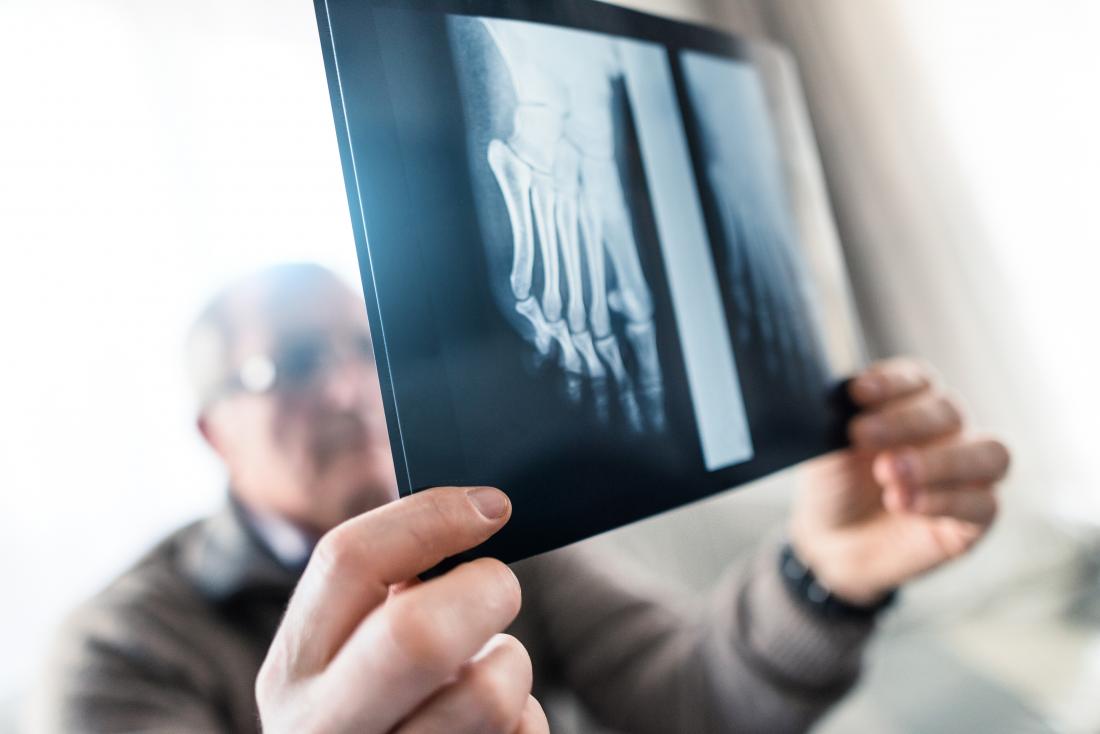The metatarsophalangeal (MTP) joint attaches the big toe to the foot. This joint is vital for supporting the body and allowing the toe to bend up and down. It helps propel a person forward by acting as a push-off point when they walk or run.
Conditions that affect the MTP joint can cause pain and swelling around the big toe. Pain at this joint can limit movement in the area and affect a person’s ability to walk.
In this article, we discuss some of the causes of pain at the big toe joint and how to treat them.
Causes
Causes of pain at the big toe joint can include:
Osteoarthritis

Osteoarthritis can cause pain and stiffness in the joints.
Osteoarthritis is a form of arthritis that occurs when the cartilage wears down at the joints.
When osteoarthritis occurs in the foot, it most commonly affects the MTP joint at the base of the big toe.
Over time, osteoarthritis in the big toe will cause the cartilage to erode and the bones to rub against each other. The friction causes pain and inflammation, which may make walking challenging.
Bony projections called bone spurs can also develop. Bone spurs and osteoarthritis can cause hallux rigidus in the big toe, which is when the movement of the big toe becomes limited.
Gout
Gout is another type of arthritis. It occurs when uric acid crystallizes in the joints.
Uric acid is a waste product that goes through the bloodstream before passing through the kidneys and out of the body as urine.
High levels of uric acid can lead to crystallization and the formation of small deposits. When this occurs in the joints, it can be very painful.
In many cases, the first symptoms of gout occur in the big toe, where it causes severe episodes of sharp pain and swelling.
Gout may also spread to other parts of the body. Over time, it can cause lumps to form under the skin in the affected areas.
Toe injuries
Many injuries can affect the big toe joint. Overuse can cause a stress fracture, which is a small crack in the bone that develops as a result of repetitive force.
Sprains are another common cause of toe pain. A sprain occurs when the ligaments in the toe become torn or stretched.
In some cases, this can be due to turf toe, a common sports injury that occurs as a result of excessive or repetitive pressure on a bent toe.
These injuries cause pain and swelling of the big toe.
Bunion
A bunion is a bony lump that develops along the inner side of the MTP joint. It can cause pain and swelling around the big toe. It can also lead to stiffness and restricted flexibility.
Occasionally, the big toe may start to turn toward the second toe, which is called a hallux valgus deformity. This condition can make it difficult for a person to wear certain types of shoe or even to walk.
Bunions can occur in anyone, but they are more common in people who wear shoes that are tight around the toes.
Sesamoiditis
Sesamoiditis is inflammation in the sesamoid bones and surrounding tendons resulting from overuse of the toe.
The sesamoid bones in the foot sit beneath the MTP joint. Tendons attach to these bones and support movement in the area.
Sesamoiditis in the foot can cause pain at the base of the big toe. It can also lead to swelling, bruising, or difficulty moving the toe.
Diagnosis

A doctor may request an X-ray to help diagnose the cause of pain at the big toe joint.
To determine the cause of pain at the big toe joint, a doctor will perform a physical examination and ask a person about their symptoms, lifestyle, medication, and any recent injuries.
They may test the flexibility of the toe by gently bending it up and down. They will also look for evidence of bone spurs and swelling in the area.
Finally, the doctor will examine the foot for areas of tenderness and check the skin to see if any sores are present.
In some cases, it may be necessary to do an X-ray. This imaging test will help the doctor assess the location and extent of any damage or deformity.
Depending on the underlying cause of the pain, further testing may be necessary. For example, a blood test can measure the level of uric acid in the bloodstream to help diagnose gout.
Treatment and relief
The type of treatment will depend on the cause of the big toe joint pain.
In many cases, a doctor will recommend a pain reliever, such as a nonsteroidal anti-inflammatory drug (NSAID).
These medications may also help reduce swelling in the area. Less commonly, a doctor may prescribe corticosteroids to reduce inflammation.
Lifestyle changes may also be necessary. For example, a person may need to treat a bunion by wearing orthopedic shoes or shoe inserts. Only wearing shoes with extra room for the toes is a good option for people with this problem.
If the injury is the result of a particular activity, it will often be necessary to avoid that activity while the injury heals. For example, treating turf toe may involve avoiding the sport that caused the injury until it improves.
In some cases, it may be important to lose weight to reduce pressure on the toe.
More specific treatments may be necessary for certain conditions, such as osteoarthritis and gout. Physical therapy may help people with arthritis manage this condition.
In rare cases, surgery may be necessary, for example, to remove a bunion or repair joint damage.
Prevention

Wearing appropriate footwear that fits well can help prevent foot pain.
Some tips for preventing pain at the big toe joint include:
- maintaining a healthy weight
- exercising regularly but trying not to place excessive strain on the MTP joint
- avoiding shoes that are too tight, particularly around the toes
- wearing appropriate footwear when at risk of injury, i.e., wearing steel-toed boots in a warehouse
When to see a doctor
In cases of mild pain or pain that gets better over time, it is not usually necessary to see a doctor. Many sprains will heal on their own during a period of rest.
However, if the symptoms do not improve after 3 days, it may be best to see a doctor as the pain could indicate a more serious issue.
It is also important to see a doctor if the pain is severe or sudden and unexplained.
Summary
Pain in the big toe joint can be due to a trauma, a chronic condition, or pressure that has built up over time. In most cases, the underlying cause is easily treatable.
Some injuries can heal on their own with rest and pain medication. However, some conditions, such as osteoarthritis, require long-term solutions.
It is possible to reduce the risk of toe injuries by making simple lifestyle changes, such as wearing appropriate footwear.
Anyone with pain at the big toe joint that gets worse over time or does not resolve should speak to a doctor.
